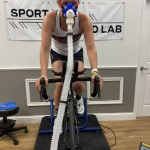Endurance sports like running, cycling, and triathlons are exhilarating, but they come with unique health risks, especially when it comes to heart health. Many athletes, including some of the most respected names in the field, have been affected by heart disease. This includes well-known figures such as runners Alberto Salazar and Ryan Shay, triathletes Emma Carney and Greg Welch, and cyclist Lennard Zinn. Tragically, these athletes either passed away due to heart-related issues or were diagnosed with serious heart conditions.
Despite these high-profile cases, many endurance athletes believe that heart disease is something that only affects others. I was one of them, until I learned the hard way. While training for the Augusta 70.3, I began experiencing symptoms I dismissed as normal fatigue. Eventually, I was diagnosed with a rare genetic heart condition called Arrhythmogenic Right Ventricular Cardiomyopathy (ARVC), which forced me to stop training and competing. Now, I’m sharing this story to raise awareness and help others understand the risks and signs of heart disease in athletes.
The Increasing Popularity of Endurance Sports
Endurance sports are more popular than ever, with the number of race finishers in the U.S. growing by nearly 300% since 1990. As more people get involved, it’s crucial to recognize that many athletes come from backgrounds with a family history of heart disease, have been smokers, or are attempting to improve their health after years of unhealthy habits. While endurance sports offer a great way to improve cardiovascular health, they also place significant strain on the body, especially the heart. It’s important to understand that being young and healthy doesn’t automatically protect you from heart issues.
Understanding the Heart’s Role in Endurance Performance
The heart is responsible for pumping oxygenated blood to the muscles and organs. It beats roughly 100,000 times a day under normal conditions. The heart has four chambers—two atria and two ventricles—and four valves that regulate blood flow. The heart’s conduction system, including the SA node, controls the heartbeat and ensures that the chambers contract in a coordinated fashion, allowing blood to flow efficiently.
However, issues arise when the system doesn’t function correctly, leading to potential cardiovascular problems that could affect an athlete’s ability to perform or even be life-threatening.
Recognizing Warning Signs of Heart Problems in Athletes
Certain signs and symptoms could indicate underlying heart issues. It’s essential to be aware of these warning signs:
- A family history of early heart disease or sudden death
- Irregular heartbeats or palpitations
- Dizziness or lightheadedness
- Fainting or passing out
- Unexplained fatigue
- Chest tightness or pain
- Shortness of breath during exercise
- Fluttering sensations in the chest
- Decreased performance or difficulty handling your normal training load
- Extreme fluctuations in heart rate during exercise
- Pain in the chest, neck, or arm while exercising
If you experience any of these symptoms, it’s vital to seek medical advice rather than ignoring them.
Common Heart Conditions in Endurance Athletes
Three primary heart issues are commonly seen in athletes:
- Arrhythmias: These involve irregularities in the heart’s electrical system, causing the heart to beat too fast, too slowly, or erratically. While not always life-threatening, arrhythmias can significantly affect athletic performance and lead to complications if not addressed.
- Cardiomyopathy: This refers to diseases of the heart muscle, including hypertrophic cardiomyopathy (HCM) and arrhythmogenic right ventricular cardiomyopathy (ARVC). Both can cause sudden cardiac death, with HCM being the more common cause among athletes. ARVC is rare but can be equally dangerous.
- Coronary Artery Disease (CAD): Typically seen in older athletes, CAD results from plaque buildup in the coronary arteries, which restricts blood flow. While CAD is less common in younger athletes, it’s still a risk, especially for those with family histories of heart disease or poor lifestyle choices.
What Can You Do to Protect Your Heart?
Raising awareness about heart health in endurance athletes is crucial. It’s essential to have open discussions with training partners, clubs, and healthcare professionals about the risks and signs of cardiac disease. If you notice any unusual symptoms in yourself or others, speak up and seek medical advice.
For athletes new to endurance sports or those with a family history of heart disease, seeing a sports cardiologist for a heart screening is a good idea. A cardiologist who specializes in athletes understands the unique demands of endurance sports and can distinguish between normal adaptations and potential health concerns. Athletes’ hearts look different from those of non-athletes, with lower resting heart rates, increased cardiac output, and sometimes abnormal EKG readings. Without the right expertise, these factors might be misinterpreted, leading to unnecessary tests or, worse, missed diagnoses.
Taking Action
I learned the hard way how vital it is to listen to your body and get the right help when things don’t feel right. Don’t ignore symptoms just because you’re young and healthy. If you’re concerned, get checked out by a specialist who understands the needs of endurance athletes. Your heart health should always be a priority, and addressing potential issues early can help ensure you continue to enjoy your sport safely.





